Hidden Plastic Waste
Air Date: Week of April 14, 2023

A new analysis claims that the UN could be underestimating the international plastic waste trade by up to $1.8 million metric tons. (Photo: Mike Carney, Flickr, CC BY-NC-ND 2.0)
There are many sources of hidden plastic in the waste that wealthy countries send to the developing world, in clothing, tires, and electronics. Grist Reporter Joseph Winters joins Host Jenni Doering to discuss how all that extra plastic waste is affecting the environment and health of people in the Global South.
Transcript
DOERING: As we just heard, donated clothing is one way that plastic has become a burden in the global south where it is shipped for reuse but often ends up as waste. And there are many other sources of hidden plastic in the waste being shipped abroad including tires, paper, and electronics. Those less obvious sources of plastic waste aren’t included in the United Nations’ estimate of the international plastic waste trade. A recent study by the International Pollutants Elimination Network found that the UN is underestimating the amount of plastic waste being shipped to developing countries by up to 1.8 million metric tons, making totals about 40% higher than previously thought. Joseph Winters has been following the story for Grist. He’s also a former Living on Earth intern. Joseph, welcome back!
WINTERS: Thanks so much for having me.
DOERING: So what categories of plastic are usually included in the old kinds of calculations? And what types of waste are typically ignored? Why are we missing out on huge categories of plastic waste here?
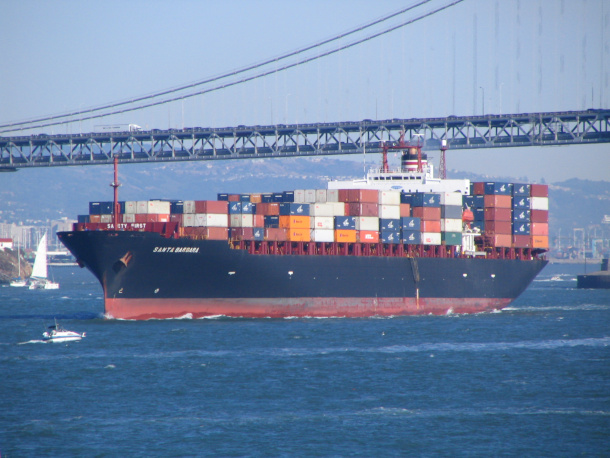
Many developed nations will send their plastic waste overseas to poorer countries. (Photo: Derrell Licht, Flickr, CC BY-ND 2.0)
WINTERS: So the way that many researchers try to quantify the amount of plastic waste that's being traded between countries uses this UN database. And in this database, plastic waste, things that you would think are obviously plastic, like bottles or plastic wrappers, things like that, they get their own code, their own category, and they're counted separately from all the other kinds of waste. And so researchers tend to look only at that category when they're making calculations about the international waste trade. And they fail to look at other categories. And so what the researchers did is they looked at a couple of these specifically around clothing. So discarded clothing gets a different code in this UN database, and it's not counted as plastic waste, it's counted as clothing waste, even though the researchers cite data showing that 60 to 70% of all textiles are made of some kind of plastic. So that's all your like synthetic fabrics. And that's not being captured by researchers. There's another category of used clothing that's sent abroad, and it's not considered waste at all. So this is clothes that wealthy countries send to the developing world thinking, oh, it's going to be recycled, it's going to be reused in a secondhand market or something like that. So that's not captured as waste at all, even though again, 60 to 70% of those textiles are made of plastic, and 40% of them likely end up in landfills, because it's just unsalvageable. It's too worn or too used.
DOERING: So in addition to clothing waste not being counted, what else is there?
WINTERS: The other big category that the researchers looked at was paper. So countries send big bales of paper waste abroad to be hopefully recycled. But it turns out that a lot of plastic sneaks into those bales. So those could be wrappers, or I guess, bottles, other plastic waste that just contaminates the bales. And the estimates for the amount of contamination in paper bales vary widely. But the report cites two sort of extremes. On the lower end, it could be just 5% of paper bales are actually plastic contamination. But the estimates go all the way up to 30%. So it could be that almost a third of these paper bales are actually plastic that's not being captured by estimates of the total international waste trade.

Although 60-70 % of clothing contains plastic, it is not traditionally considered plastic waste. (Photo: Bella Ella Boutique, Flickr, CC BY-SA 2.0)
DOERING: That's huge. Yeah, sometimes junk mail, it's an envelope, it's paper, but it's, there's also plastic stuff in there. I imagine that could be contaminating it, too.
WINTERS: Yeah, there are just lots of ways for plastic to get into paper bales.
DOERING: Yeah, I mean, plastic is in just almost everything we use these days. Are there any other categories that really are being missed here?
WINTERS: Yeah, there's a number of other categories that the report said were hard to quantify, but are still likely very problematic. And those include e-waste. So all of the electronics that countries throw away and send to the developing world are laced with plastic and other problematic components. They also talk about rubber, so largely from tires that are discarded and sent abroad. And then there's another category called Refuse Derived Fuel. It's a kind of fuel that has a lot of plastic in it.

Another category of plastic waste that is often overlooked is e-waste, or discarded electronics that contain plastic. (Photo: Marco Assini, Flickr, CC BY-SA 2.0)
DOERING: So China, which used to receive much of our plastic waste, actually stopped accepting recyclable waste from other countries in 2018, under what was called the Operation National Sword. Which countries are now bearing the brunt of this burden?
WINTERS: Yeah, so after the National Sword Policy passed in China, countries in the developing world like in Latin America, in Southeast Asia, they begin increasing their plastic imports. There's data from the Basel Action Network, which quantifies the international plastic waste trade showing that these imports have increased, in particular in places like Indonesia, Vietnam, Malaysia, the Philippines, Turkey, and many countries in South America.
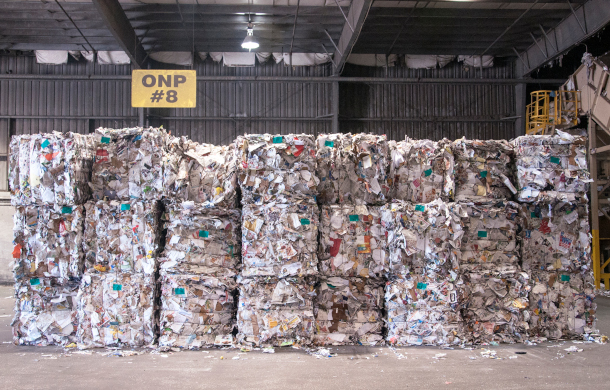
Paper bales, which richer countries send overseas to be recycled, can be contaminated with plastic. (Photo: Chris Bentley, Flickr, CC BY-NC-ND 2.0)
DOERING: Well, developed countries that are sending this waste elsewhere often claim that they're recycling that material overseas. But that's not always the case, right? What happens to the plastic waste that doesn't get recycled?
WINTERS: Unfortunately, most of the world's plastic waste is never recycled. When it's not recycled, it's either incinerated, so burned, or sent to a landfill, or in a sort of worst case scenario, it's just dumped directly into the environment, or into a sort of uncontrolled dumping site.
DOERING: And why should we care about this? I mean, what risks does plastic waste pose to human health and the environment?
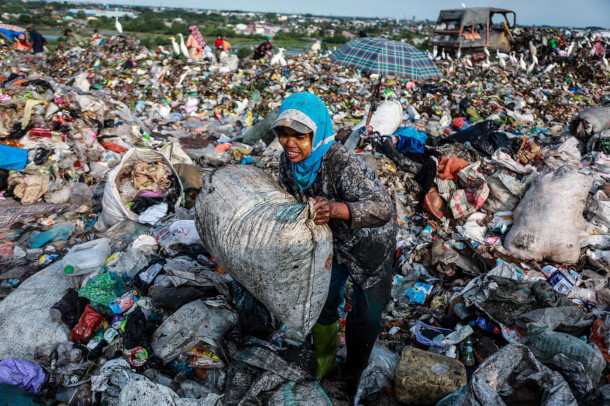
When developed nations send plastic waste to developing countries like Indonesia, it is often incinerated or dumped directly into the environment. (Photo: Basel Action Network, Flickr, CC BY-NC-ND 2.0)
WINTERS: Yeah, plastic poses a number of health risks to people and risks to the natural world, especially in some of those disposal methods that are that are not recycling. So a lot of the risks come from the fact that plastic is made from fossil fuels and includes thousands and thousands of chemicals, many of which are hazardous to human health. So when plastics are incinerated, those chemicals are released into the air as airborne pollution, which puts people at greater risk of cancer, lung disease, things like that. When plastics are landfilled or dumped in an uncontrolled site, those same chemicals can leach into the soil or the groundwater, contaminating the food that people eat, or the water that they're going to drink. There are also risks from plastic just by virtue of it being plastic. Plastic breaks down over time into smaller and smaller fragments known as microplastics that have wide ranging yet poorly understood consequences for the environment and people's health. Some people are concerned that microplastics attract microbes and other pathogens onto them, serving as sort of concentrators for those bad things. And then, when fish or small organisms eat them, they can be impacted. If they're part of the human food chain, meaning they're a fish or another animal that humans like to eat, then those pathogens can be introduced into the humans.
DOERING: So pathogens, viruses, bacteria, and, of course, all of those PFAS chemicals and phthalates and PCBs that some plastics contain.
WINTERS: Yeah, there are just a huge array of risks related to plastics and our over reliance on them.
DOERING: Well, so maybe now this report helps us perhaps calculate plastic waste a little bit better. So that's great that we have more awareness of the issue, hopefully. But what can we actually do about this problem? How can we deal with this massive crisis of plastic waste? And what is the way forward here?
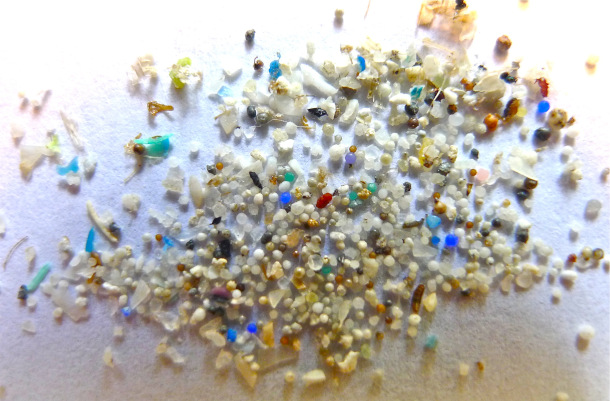
Plastics contain thousands of harmful chemicals that can leach into soil and groundwater. (Photo: Oregon State University, Flickr, CC BY-SA 2.0)
WINTERS: What I hear again, and again, from environmental advocates, and scientists and policy experts, is that we need to stop focusing so much on downstream solutions. So yes, while it's important to clean up pollution that's already out there, the focus should be on what they call turning off the plastic tap. So the analogy that's always drawn is that if you consider plastic production as the spout in a bathtub, this bathtub is filling up at a rapid rate. It's overflowing, in fact. And so before we can really drain the bathtub, we have to turn off the tap. We have to limit plastic production. People are calling for a cap on global plastic production to be enforced by a global plastics treaty that's being negotiated right now as part of the UN process.
DOERING: Yeah. I was wondering to what extent might this more accurate calculation of how much plastic waste is getting shipped to developing countries, how might that influence the UN plastics treaty?
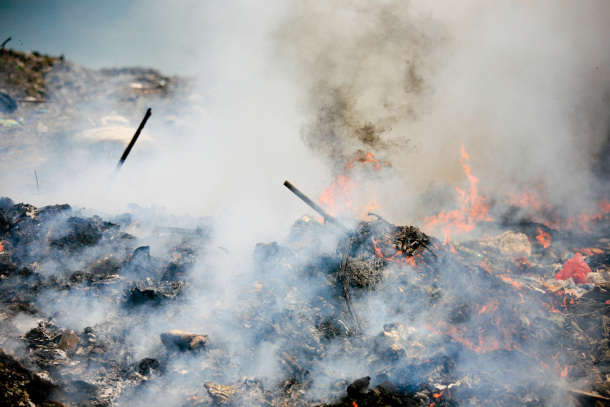
When plastic is burned, harmful chemicals are released as airborne pollution. (Photo: Alex Proimos, Flickr, CC BY-NC 2.0)
WINTERS: I think these updated numbers can serve as a sort of wake up call to policymakers. There's sort of a moral imperative here, I think. The numbers were already bad, but showing that they're even worse? I don't know, I think it can add fuel to the fire for people who are saying that this is, you know, waste colonialism. The developing world shouldn't bear the brunt of wealthy countries' large and growing appetite for plastic products.
DOERING: Joseph Winters is a reporter for Grist and a former Living on Earth intern. Thank you so much, Joseph.
WINTERS: Thanks, Jenny.
Links
Living on Earth wants to hear from you!
Living on Earth
62 Calef Highway, Suite 212
Lee, NH 03861
Telephone: 617-287-4121
E-mail: comments@loe.org
Newsletter [Click here]
Donate to Living on Earth!
Living on Earth is an independent media program and relies entirely on contributions from listeners and institutions supporting public service. Please donate now to preserve an independent environmental voice.
NewsletterLiving on Earth offers a weekly delivery of the show's rundown to your mailbox. Sign up for our newsletter today!
 Sailors For The Sea: Be the change you want to sea.
Sailors For The Sea: Be the change you want to sea.
 The Grantham Foundation for the Protection of the Environment: Committed to protecting and improving the health of the global environment.
The Grantham Foundation for the Protection of the Environment: Committed to protecting and improving the health of the global environment.
 Contribute to Living on Earth and receive, as our gift to you, an archival print of one of Mark Seth Lender's extraordinary wildlife photographs. Follow the link to see Mark's current collection of photographs.
Contribute to Living on Earth and receive, as our gift to you, an archival print of one of Mark Seth Lender's extraordinary wildlife photographs. Follow the link to see Mark's current collection of photographs.
 Buy a signed copy of Mark Seth Lender's book Smeagull the Seagull & support Living on Earth
Buy a signed copy of Mark Seth Lender's book Smeagull the Seagull & support Living on Earth

